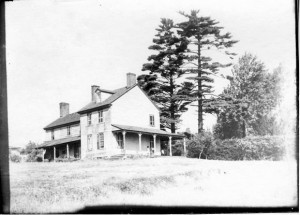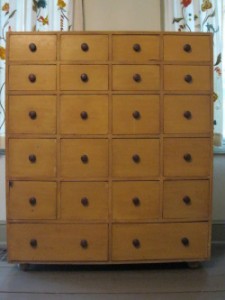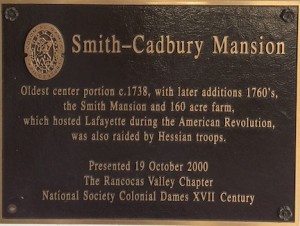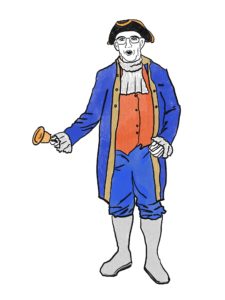 One of the Historical Society’s first acts after forming in 1969 was, in 1970, to purchase one of the oldest houses in Moorestown which happened to be for sale at the time. Today the Smith-Cadbury Mansion sits off of Main Street in Moorestown on a tiny pie-shaped lot, surrounded by 19th and 20th century homes. But when the house was built in 1738 or before, it was the centerpiece of a large farm located just to the south of the old Kings Highway (now Main St.), with the front door (now a side door) facing the road. Because of modern development, the house is now entered off of High Street, just south of Main Street. The center portion of the dwelling is the original section, with the parlor and kitchen wings added sometime before the late 1760s. Even with a few Victorian porch amenities and some interior changes during the 20th century, the house still retains the ambience of the mid-eighteenth century.
One of the Historical Society’s first acts after forming in 1969 was, in 1970, to purchase one of the oldest houses in Moorestown which happened to be for sale at the time. Today the Smith-Cadbury Mansion sits off of Main Street in Moorestown on a tiny pie-shaped lot, surrounded by 19th and 20th century homes. But when the house was built in 1738 or before, it was the centerpiece of a large farm located just to the south of the old Kings Highway (now Main St.), with the front door (now a side door) facing the road. Because of modern development, the house is now entered off of High Street, just south of Main Street. The center portion of the dwelling is the original section, with the parlor and kitchen wings added sometime before the late 1760s. Even with a few Victorian porch amenities and some interior changes during the 20th century, the house still retains the ambience of the mid-eighteenth century.
The house was built by Joshua Humphries, possibly on the foundation of an even older home. In 1766 the 160-acre property was purchased by Samuel Smith of Burlington, who was a state provincial assemblyman, Treasurer of the Province of West Jersey and the author of the first comprehensive history of New Jersey. Although Samuel never lived in this house, the farm was inherited in 1775 by his son, Richard S., who lived here for all of his adult life. Richard was a merchant, a farmer, a state assemblyman and township freeholder and committeeman.
The Smith home was the largest and most gracious in town and many well-know people were entertained there. During the American Revolutionary War, according to oral tradition, the Marquis de Lafayette and his aides were guests of Richard Smith. Less welcome guests were the Hessian General von Knyphausen and his officers. They were part of the British Army which was retreating from Philadelphia on June 19th and 20th, 1778. Tradition states that during their stop at the Smith house the soldiers killed and dressed all the chickens in the parlor and feasted and reveled far into the night.
In 1798 the house and farm came to the ownership of Edward Harris, Sr., a newly arrived merchant from England. Mr. Harris exported clover seed and also grew raspberries, apples and barley on the farm. He opened his home to visitors and allowed traveling clergy to preach to their flocks on the front porch and in the parlor. His son, Edward Harris, Jr. inherited the property at his father’s death in 1822 and lived there until 1849. He also farmed the land and lived the life of a scholar and gentleman. He was a naturalist and accompanied his friend, John James Audubon on two expeditions. Harris was an early benefactor of Audubon, supporting his work when he was a young struggling artist, and it is believed that Audubon visited the farm in Moorestown on several occasions.
Harris was the first to introduce the Percheron horse to the United States and he bred these horses on the farm. Following the Harris ownership, the property changed hands several times. Bartholomew Sutton was the last to farm the land in the 1890s. Through the following years the Smith house remained a residence, but the land was gradually partitioned into smaller town lots. In 1924, the house was purchased by John and Rachael Cadbury, with Mrs. Cadbury living there until her death in 1969.
Today the Smith-Cadbury Mansion, so named by the Historical Society, is the headquarters of the Society. The home is fortunate to contain much of the original paneling, floorboards, fireplaces and even window glass. As a dwelling continuously lived in from 1738 to 1969, today the furnishings of the museum-house reflect styles from the 18th and 19th century and are not pristine to a particular time. There are many items in the collection that have passed through the Cadbury and other local families. Among the important pieces in the Historical Society collection are samplers including one of the earliest schoolgirl samplers made at the Westtown School, quilts, early Quaker clothing, tall-case clocks such as a Peter Stretch clock from Philadelphia, and a Morgan Hollingshead clock from Moorestown, a William McElroy Windsor chair made in Moorestown, and other fine antique furniture. Off the 1738 dining room, the Historical Society maintains a lovely Gift Shop in a Victorian enclosed porch. Here visitors can purchase a variety of items for house and garden and books on local history.
The Smith-Cadbury Mansion is listed on the New Jersey State and National Register of Historic Places and has been recognized by the National Society Colonial Dames XVII Century with an official plaque.

Photo right: Painted chest belonging to Edward Harris, II of Moorestown. One of Edward Harris’s hobbies was ornithology. When Harris lived in Moorestown, this chest held over 400 bird skins from his collection. Edward Harris and his good friend John James Audubon acquired the birds when they went on two collecting excursions in the mid-west, in 1837 & 1843. Photo and description, Lisa Hammell.




